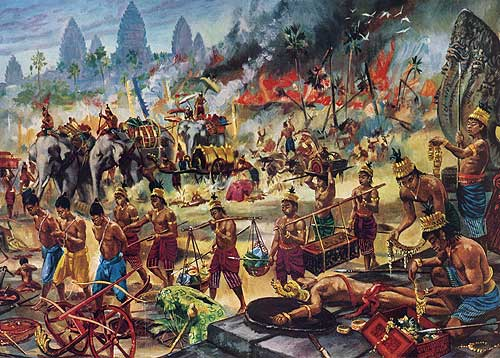Innovative Agricultural Techniques in Angkor: A Legacy of the Khmer Empire
Introduction: Celebrating Khmer Empire’s Agricultural Innovations
Join us in exploring the innovative agricultural techniques of the Khmer Empire. Their ground breaking techniques were vital for survival and economic prosperity in Angkor.
Hydrological Engineering: The Core of Khmer Agriculture
The Khmer Empire’s success in agriculture relied heavily on their hydrological engineering skills. Skilfully constructed reservoirs and canals formed a vast irrigation network, crucial for farming productivity and flood management, especially in the West and East Baray areas.
Rice Cultivation: Pillar of Khmer Food Security
Rice farming was fundamental to Angkor’s sustenance. The Khmer’s advanced agricultural techniques, particularly terracing, enhanced land and water management. Crop rotation rejuvenated the soil, ensuring lasting agriculture.
Advanced Water Management: Beyond Simple Irrigation
Moreover, Khmer water management strategies supported transportation and economic growth. Canals facilitated fish farming, augmenting the food supply. These systems were key in managing floods during monsoon seasons.
Terracing and Soil Conservation: Sustainable Practices
The Khmer Empire effectively countered soil erosion through innovative agricultural techniques that included terracing. They embraced organic fertilizers for healthier soil. Contour ploughing was another method they used to enhance water retention.
Innovative Agricultural Techniques: Merging Nature with Farming
The Khmer skilfully combined agroforestry with conventional farming. Planting fruit trees among crops, they improved soil health and diversified food sources, positively impacting local diets and economies.
The Downfall of Angkor: A Multidimensional Crisis
Several factors led to Angkor’s decline:
Environmental Challenges: Straining Agriculture
Extreme droughts and erratic rainfall put immense pressure on the intricate water systems, disrupting food production and security.
Population Growth: Testing Agricultural Limits
Rapid population growth strained resources. This pressure caused the agricultural systems to falter, resulting in food shortages.
Political Upheaval: Impacting Agricultural Management
Domestic conflicts and political instability adversely affected the management and maintenance of agricultural infrastructures.
External Pressures: Adversities from Neighbours
Neighbouring kingdom pressures interrupted trade, further challenging agricultural endurance.
Shift in Power: Angkor’s Era Concludes
As the empire’s influence waned, the central focus shifted towards Phnom Penh, marking the end of Angkor’s golden age.
Conclusion: Honouring Khmer Agricultural Ingenuity
The Khmer Empire’s expertise in agricultural techniques, including hydrological engineering and diverse farming methods, fuelled Angkor’s wealth. Their lasting legacy stands as a testament to their resilience and innovative spirit.
For an engaging journey through Siem Reap’s historical treasures and the marvels of the Khmer Empire, connect with Tola. Uncover the rich legacy of a civilization that masterfully shaped its environment.

